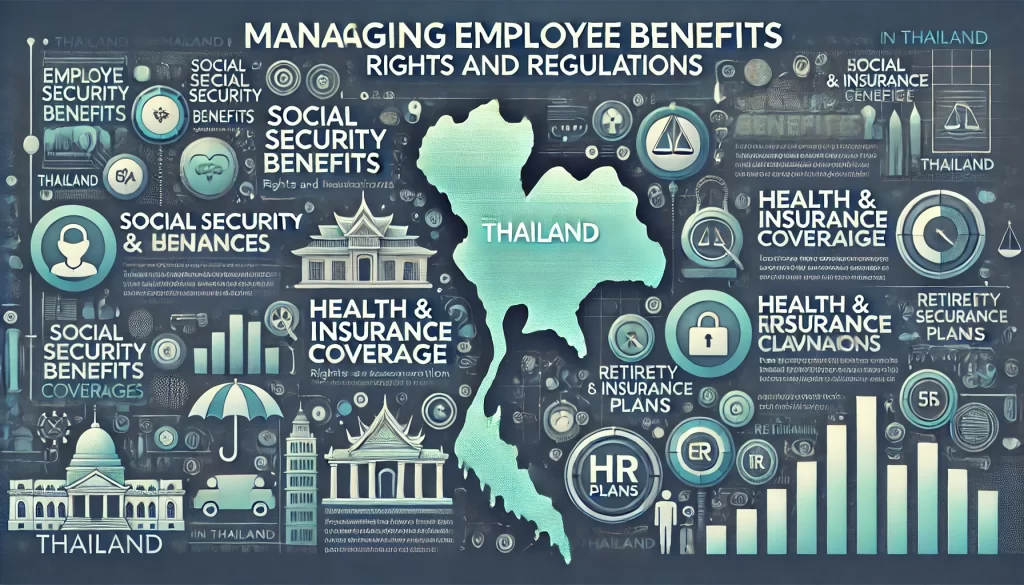🌴 Welcome to the Land of Smiles… and Employee Benefits! 🌴
Are you an HR professional or business owner navigating the complex world of employee benefits in Thailand? You’re not alone. With a unique blend of cultural traditions and modern labor laws, managing employee benefits in the Land of Smiles can feel like trying to untangle a plate of pad thai noodles. But fear not! Whether you’re dealing with mandatory social security contributions or pondering popular optional perks, we’ve got you covered.
Imagine confidently steering your company through Thailand’s legal labyrinth, ensuring your employees are not just satisfied, but thriving. From understanding the core benefits required by law to implementing best practices that will make your HR department shine, this comprehensive guide will equip you with the knowledge to turn potential headaches into opportunities for employee engagement and retention. Ready to become a master of Thai employee benefits? Let’s dive in and explore the rights, regulations, and rewards that await!
Overview of Employee Benefits in Thailand

A. Mandatory benefits
In Thailand, employers are required to provide a set of mandatory benefits to their employees. These benefits are designed to ensure basic protection and welfare for workers. Here’s a breakdown of the key mandatory benefits:
- Social Security Fund (SSF)
- Workmen’s Compensation Fund (WCF)
- Provident Fund (optional for employers, but mandatory if established)
- Annual leave
- Sick leave
- Maternity leave
| Benefit | Description | Employer Contribution |
|---|---|---|
| SSF | Covers healthcare, disability, death, child allowance, old-age pension, and unemployment | 5% of salary (capped) |
| WCF | Provides compensation for work-related injuries or illnesses | 0.2% – 1% of payroll |
| Annual Leave | Minimum 6 days per year after 1 year of service | Full pay |
| Sick Leave | Up to 30 days per year | Full pay |
B. Optional benefits
Many Thai companies offer additional benefits to attract and retain talent:
- Health insurance
- Life insurance
- Dental coverage
- Transportation allowance
- Housing allowance
- Performance bonuses
- Employee stock options
- Professional development opportunities
C. Cultural considerations
When managing employee benefits in Thailand, it’s crucial to consider cultural aspects:
- Family-oriented benefits: Thai culture highly values family, so benefits that support family life are appreciated.
- Respect for seniority: Benefits that acknowledge long-term service or higher positions are well-received.
- Face-saving: Avoid public comparisons of benefits between employees to maintain harmony.
- Buddhist holidays: Consider offering time off for important religious observances.
Understanding these cultural nuances can help employers tailor their benefits packages to better meet employee expectations and foster a positive work environment.
Legal Framework for Employee Benefits

Labor Protection Act
The Labor Protection Act (LPA) forms the cornerstone of Thailand’s employee benefits framework. This comprehensive legislation outlines the minimum standards for working conditions and employee rights, including:
- Minimum wage requirements
- Maximum working hours
- Overtime compensation
- Holiday entitlements
- Maternity leave provisions
Employers must adhere to these regulations to ensure compliance and foster a fair work environment.
| Key Provisions | Details |
|---|---|
| Working Hours | 8 hours/day, 48 hours/week |
| Overtime Pay | 1.5-3 times regular wage |
| Annual Leave | Minimum 6 days after 1 year |
| Maternity Leave | 98 days (45 paid by employer) |
Social Security Act
The Social Security Act (SSA) establishes a comprehensive social protection system for employees in Thailand. It mandates contributions from both employers and employees to fund various benefits:
- Medical care
- Disability compensation
- Unemployment benefits
- Old-age pension
- Child allowance
These benefits provide a safety net for workers and their families, ensuring financial security in various life situations.
Workmen’s Compensation Act
This act specifically addresses workplace injuries and occupational diseases. Key provisions include:
- Medical treatment coverage
- Work rehabilitation services
- Compensation for lost wages
- Funeral expenses in case of death
Employers are required to provide these benefits either through direct payment or by contributing to the Workmen’s Compensation Fund.
Taxation laws affecting benefits
Thailand’s tax laws significantly impact employee benefits. Some key considerations include:
- Taxable vs. non-taxable benefits
- Deduction limits for certain benefits
- Tax implications of provident funds
Understanding these laws is crucial for both employers and employees to optimize benefit packages while remaining compliant with tax regulations.
Now that we’ve covered the legal framework, let’s explore the core mandatory benefits that Thai employers must provide to their workforce.
Core Mandatory Benefits

Social security contributions
In Thailand, both employers and employees are required to contribute to the Social Security Fund. This system provides crucial benefits to workers, including:
- Medical care
- Disability compensation
- Old-age pension
- Child allowance
- Unemployment benefits
The contribution rates are as follows:
| Contributor | Rate (% of salary) | Monthly Cap (THB) |
|---|---|---|
| Employer | 5% | 750 |
| Employee | 5% | 750 |
Workmen’s compensation insurance
Employers must provide workmen’s compensation insurance to protect employees in case of work-related injuries or illnesses. This coverage includes:
- Medical expenses
- Rehabilitation costs
- Compensation for lost wages
- Disability benefits
- Death benefits for surviving family members
Annual leave and public holidays
Thai labor law mandates minimum annual leave and public holiday entitlements:
- Annual leave: 6 days per year for employees who have worked continuously for one year
- Public holidays: 13 official holidays annually
Employees working on public holidays are entitled to additional compensation or time off in lieu.
Severance pay
Severance pay is a crucial benefit for employees in Thailand. The amount depends on the length of service:
| Length of Service | Severance Pay |
|---|---|
| 120 days – 1 year | 30 days’ wages |
| 1 – 3 years | 90 days’ wages |
| 3 – 6 years | 180 days’ wages |
| 6 – 10 years | 240 days’ wages |
| 10+ years | 300 days’ wages |
These core mandatory benefits form the foundation of employee rights in Thailand. Understanding and implementing them correctly is essential for compliance and maintaining positive employer-employee relationships. Next, we’ll explore additional statutory benefits that complement these core offerings.
Additional Statutory Benefits

Maternity leave and benefits
In Thailand, maternity leave is a crucial statutory benefit that supports working mothers. Employers are required to provide 98 days of maternity leave, including both pre and post-natal periods. The first 45 days are fully paid by the employer, while the remaining 53 days are covered by social security at 50% of the employee’s salary.
| Maternity Leave Component | Duration | Payment |
|---|---|---|
| Employer-paid leave | 45 days | 100% |
| Social Security-paid leave | 53 days | 50% |
Sick leave
Thai labor law mandates that employees are entitled to sick leave with pay for up to 30 days per year. This benefit ensures that workers can take time off to recover from illnesses without financial strain. Key points about sick leave include:
- Full pay for the duration of the leave (up to 30 days)
- Medical certificate required for leaves exceeding 3 consecutive days
- Employers cannot terminate employees for taking sick leave
Military service leave
Military service leave is another important statutory benefit in Thailand, particularly for male employees who may be called for military duty. The provisions for this leave include:
- Up to 60 days of paid leave per year for military service
- Applicable for both voluntary and mandatory military service
- Employees must provide proper documentation from military authorities
These additional statutory benefits complement the core mandatory benefits, forming a comprehensive employee benefits package in Thailand. As we move forward, we’ll explore popular optional benefits that many Thai companies offer to attract and retain top talent.
Popular Optional Benefits
Health insurance
Health insurance is one of the most sought-after optional benefits in Thailand. Many companies offer comprehensive health coverage to attract and retain top talent. Here’s a comparison of typical health insurance offerings:
| Coverage Type | Basic Plan | Premium Plan |
|---|---|---|
| Outpatient | ✓ | ✓✓ |
| Inpatient | ✓ | ✓✓✓ |
| Dental | ✗ | ✓ |
| Vision | ✗ | ✓ |
| Maternity | ✗ | ✓✓ |
Provident funds
Provident funds are voluntary savings schemes that both employers and employees contribute to. They offer tax benefits and help employees save for retirement. Key features include:
- Contributions are tax-deductible
- Employers often match employee contributions
- Funds are professionally managed
- Withdrawals are possible upon resignation or retirement
Performance bonuses
Performance-based bonuses incentivize employees to excel in their roles. Common types include:
- Annual bonuses tied to company performance
- Individual performance bonuses
- Project completion bonuses
- Sales commissions
Training and development programs
Investing in employee growth is crucial for long-term success. Popular training initiatives include:
- Leadership development workshops
- Technical skills training
- Language courses (especially English)
- Cross-functional training opportunities
Employee wellness initiatives
Wellness programs promote a healthier, more productive workforce. Some popular options are:
- Gym memberships or on-site fitness facilities
- Mental health support services
- Nutritional counseling
- Stress management workshops
These optional benefits can significantly enhance an employer’s value proposition, leading to improved employee satisfaction and retention. When designing a benefits package, companies should consider their workforce’s needs and preferences to create a competitive and attractive offering.
Managing Employee Benefits Effectively

Designing competitive benefits packages
To attract and retain top talent in Thailand’s competitive job market, HR professionals must craft compelling benefits packages. Consider the following strategies:
- Benchmark against industry standards
- Tailor offerings to employee demographics
- Balance mandatory and optional benefits
| Benefit Type | Examples | Importance |
|---|---|---|
| Core | Social security, workmen’s compensation | Legal requirement |
| Additional Statutory | Annual leave, maternity leave | Employee satisfaction |
| Optional | Health insurance, retirement plans | Competitive edge |
Communicating benefits to employees
Effective communication is crucial for employees to understand and appreciate their benefits:
- Conduct regular benefits orientation sessions
- Provide clear, concise written materials
- Utilize digital platforms for easy access to information
- Offer one-on-one consultations for personalized guidance
Ensuring compliance with regulations
Staying compliant with Thai labor laws is essential to avoid legal issues and maintain a positive reputation:
- Stay updated on changes in labor legislation
- Conduct regular audits of benefits administration
- Partner with local legal experts for guidance
- Implement robust record-keeping systems
Regularly reviewing and updating benefits
To keep benefits packages competitive and relevant:
- Conduct annual reviews of benefits offerings
- Gather employee feedback through surveys and focus groups
- Analyze utilization rates of current benefits
- Stay informed about emerging trends in the Thai job market
By implementing these strategies, HR professionals can effectively manage employee benefits, ensuring both compliance and employee satisfaction. This approach not only helps in attracting top talent but also contributes to long-term employee retention and overall organizational success.
Challenges in Thai Employee Benefits Management

Rising healthcare costs
One of the most significant challenges in managing employee benefits in Thailand is the rising cost of healthcare. This trend has a direct impact on both employers and employees:
- Increased premiums for health insurance
- Higher out-of-pocket expenses for medical treatments
- Greater financial burden on companies providing comprehensive health coverage
To illustrate the impact, consider the following table:
| Year | Average Annual Healthcare Cost per Employee (THB) | % Increase |
|---|---|---|
| 2018 | 15,000 | – |
| 2019 | 16,200 | 8% |
| 2020 | 17,800 | 10% |
| 2021 | 19,600 | 10% |
Changing workforce demographics
The evolving demographics of the Thai workforce present unique challenges for benefits management:
- Aging population requiring more comprehensive health coverage
- Millennials and Gen Z employees seeking different types of benefits
- Increasing number of expatriate workers with diverse benefit expectations
Balancing costs with employee satisfaction
HR professionals must strike a delicate balance between controlling benefit costs and maintaining employee satisfaction. This challenge involves:
- Analyzing the cost-effectiveness of different benefit packages
- Conducting regular employee surveys to understand preferences
- Implementing flexible benefit options to cater to diverse needs
Keeping up with regulatory changes
The dynamic nature of Thai labor laws and regulations poses ongoing challenges:
- Frequent updates to social security and labor protection acts
- Changes in tax implications for certain benefits
- New compliance requirements for multinational companies
HR managers must stay vigilant and adapt their benefit strategies accordingly to ensure compliance and avoid potential legal issues. This constant need for adaptation adds complexity to the already challenging task of managing employee benefits in Thailand.
Best Practices for HR Professionals

Conducting regular benefits audits
Regular benefits audits are crucial for HR professionals to ensure compliance and optimize employee satisfaction. These audits help identify gaps, redundancies, and opportunities for improvement in the benefits package. Here’s a step-by-step approach to conducting effective benefits audits:
- Establish audit frequency (e.g., annually or bi-annually)
- Review current benefits offerings
- Assess compliance with Thai labor laws
- Analyze utilization rates
- Evaluate cost-effectiveness
| Audit Component | Purpose | Frequency |
|---|---|---|
| Legal Compliance | Ensure adherence to Thai regulations | Annually |
| Cost Analysis | Optimize budget allocation | Bi-annually |
| Utilization Review | Identify popular and underused benefits | Quarterly |
| Employee Satisfaction | Gauge effectiveness of current offerings | Annually |
Leveraging technology for benefits administration
Implementing HR technology can streamline benefits administration, reducing errors and improving efficiency. Key advantages include:
- Automated enrollment processes
- Real-time updates on benefits usage
- Enhanced data security
- Improved communication with employees
Benchmarking against industry standards
Staying competitive in the Thai job market requires regular benchmarking of benefits packages. HR professionals should:
- Compare offerings with similar companies in Thailand
- Identify trends in emerging benefits
- Adjust packages to remain attractive to top talent
Gathering employee feedback on benefits
Employee input is invaluable for tailoring benefits to workforce needs. Effective methods include:
- Annual surveys
- Focus groups
- One-on-one interviews
- Suggestion boxes (physical or digital)
By incorporating these best practices, HR professionals can create a robust and appealing benefits package that supports employee well-being and organizational goals in Thailand’s competitive labor market.
Navigating the landscape of employee benefits in Thailand requires a comprehensive understanding of legal requirements and cultural expectations. From mandatory benefits like social security and workmen’s compensation to optional perks such as health insurance and performance bonuses, Thai employers have a range of tools at their disposal to attract and retain top talent. Effective management of these benefits not only ensures compliance with local regulations but also contributes to employee satisfaction and overall organizational success.
As HR professionals and business leaders in Thailand, it’s crucial to stay informed about the latest developments in employee benefits legislation and best practices. By striking a balance between legal obligations and competitive offerings, companies can create a benefits package that supports their workforce while aligning with business objectives. Remember, a well-designed and properly managed benefits program is an investment in your employees’ well-being and your company’s future.

